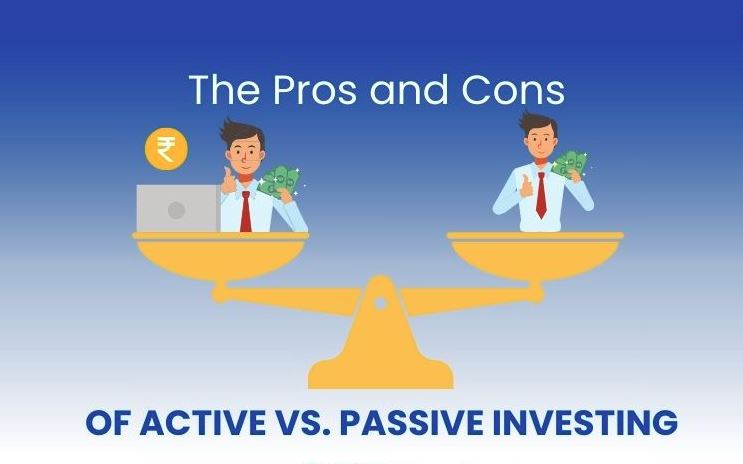Investing is a critical component of wealth-building, and determining the right strategy can significantly affect your financial future. Among the most debated approaches are active and passive investing. Each method has its own set of advantages and disadvantages, appealing to different types of investors based on their goals, risk tolerance, and investment philosophy. Here’s an overview of the pros and cons of both active and passive investing.
The Pros and Cons of Active vs. Passive Investing
Active Investing
Active investing involves a hands-on approach where investors or fund managers make decisions about buying and selling assets in an attempt to outperform a benchmark index. This strategy requires continuous analysis of market conditions and securities.
Pros:
- Potential for Higher Returns:
– Active investors have the opportunity to outperform the market by picking winning stocks and timing the market effectively.
- Market Efficiency:
– Active management can benefit from market inefficiencies. Skilled fund managers can capitalize on discrepancies in pricing and take advantage of short-term price movements.
- Flexibility:
– Active strategies allow investors to quickly react to market changes, news, and economic indicators, enabling them to adjust their portfolios in response to evolving market conditions.
- Personalization:
– Investors can tailor their portfolios to align with their specific investment objectives and risk tolerance, allowing for a more customized investment strategy.
- Diversification Opportunities:
– Active funds can invest in a wider range of sectors, asset classes, and geographical regions, potentially providing better diversification.
Cons:
- Higher Costs:
– Active investing usually involves higher fees, including management fees and trading costs, which can eat into overall returns.
- Underperformance Risk:
– Many active managers fail to consistently outperform their benchmarks after fees are taken into account. This means that the average active fund may underperform index funds over the long term.
- Time and Effort:
– Successful active investing requires significant time, research, and discipline. Investors must stay informed about market trends, economic indicators, and specific companies.
- Emotional Decision-Making:
– The hands-on nature of active investing can lead to emotional decision-making, where investors may react impulsively to market fluctuations rather than sticking to a disciplined strategy.
Passive Investing
Passive investing is a more hands-off approach where investors seek to replicate the performance of a specific index, such as the S&P 500, by investing in index funds or exchange-traded funds (ETFs). This strategy is based on the belief that markets are generally efficient, and it’s challenging to consistently beat the market.
Pros:
- Lower Costs:
– Passive investing generally has lower fees than active investing due to fewer transaction costs and lower management expenses. This can lead to higher net returns over time.
- Simplicity and Convenience:
– Passive investing is easier for most investors, requiring less time and effort. Investors can buy and hold index funds without needing to monitor the market constantly.
- Consistent Performance:
– By tracking an index, passive funds usually deliver market returns, with a reduced risk of significant underperformance compared to active funds.
- Reduced Emotional Stress:
– A passive approach minimizes emotional reactions to market volatility. Investors can maintain a long-term perspective without the stress of frequent trading.
- Diversification:
– Index funds inherently offer diversification by including a broad range of stocks within a single investment.
Cons:
- Limited Upside Potential:
– Passive investors may miss out on opportunities for higher returns since they are not actively selecting stocks or timing the market.
- Lack of Control:
– Investors have no control over the specific securities held in an index fund, which can be limiting if they want to avoid certain sectors or companies.
- Market Risk:
– Passive investing does not hedge against market downturns. If the market declines, the value of index funds will also fall, reflecting the broader market’s performance.
- No Active Decision-Making:
– Passive investors need to accept that they may not outperform the market, which can be frustrating for those who believe they have the skills to make better investment decisions.
Conclusion
Both active and passive investing have their merits and drawbacks, and the right choice depends on individual financial goals, investment horizon, and risk tolerance.
– Active investing offers the potential for higher returns and personalized strategies but comes with higher costs and the risk of underperformance.
– Passive investing is cost-effective and straightforward, promoting market returns but lacking the opportunity to exceed those returns and requiring a long-term mindset.
Ultimately, a balanced investment approach, possibly combining elements of both strategies, may provide the best of both worlds and can serve to diversify one’s investment portfolio. As with any investment strategy, it’s essential to do thorough research or consult a financial advisor to align your investing approach with your financial goals.


